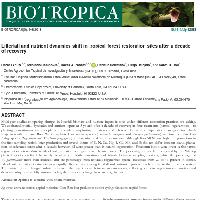Resumen
- Multi-year studies comparing changes in litterfall biomass and nutrient inputs in sites under different restoration practices are lacking. We evaluated litterfall dynamics and nutrient inputs at 5 yr and after a decade of recovery in four treatments (natural regeneration—no planting, plantation—entire area planted, tree islands—planting in patches, and reference forest) at multiple sites in an agricultural landscape in southern Costa Rica. We interplanted two native species (Terminalia amazonia and Vochysia guatemalensis) and two naturalized N-fixing species (Inga edulis and Erythrina poeppigiana) in plantation and island treatments. Although litterfall N was higher in plantations in the first sampling period, litter production and overall inputs of C, N, Ca, Mg, P, Cu, Mn, and Fe did not differ between island, plantation, or reference forest after a decade; however, all were greater than in natural regeneration. Potassium inputs were lower in the natural regeneration, intermediate in island and plantation, and greater in reference forest. The percentage of litterfall comprised by the N-fixing planted species declined by nearly two-thirds in both plantations and islands between sampling periods, while the percentage of V. guatemalensis more than doubled, and the percentage from naturally regenerated species increased from 27 to 47 percent in islands. Island and plantation treatments were equally effective at restoring litterfall and nutrient inputs to levels similar to the reference system. The nutrient input changed substantially over the 7-yr interval between measurements, reflecting shifts in vegetation composition and demonstrating how rapidly nutrient cycling dynamics can change in recovering forests.
